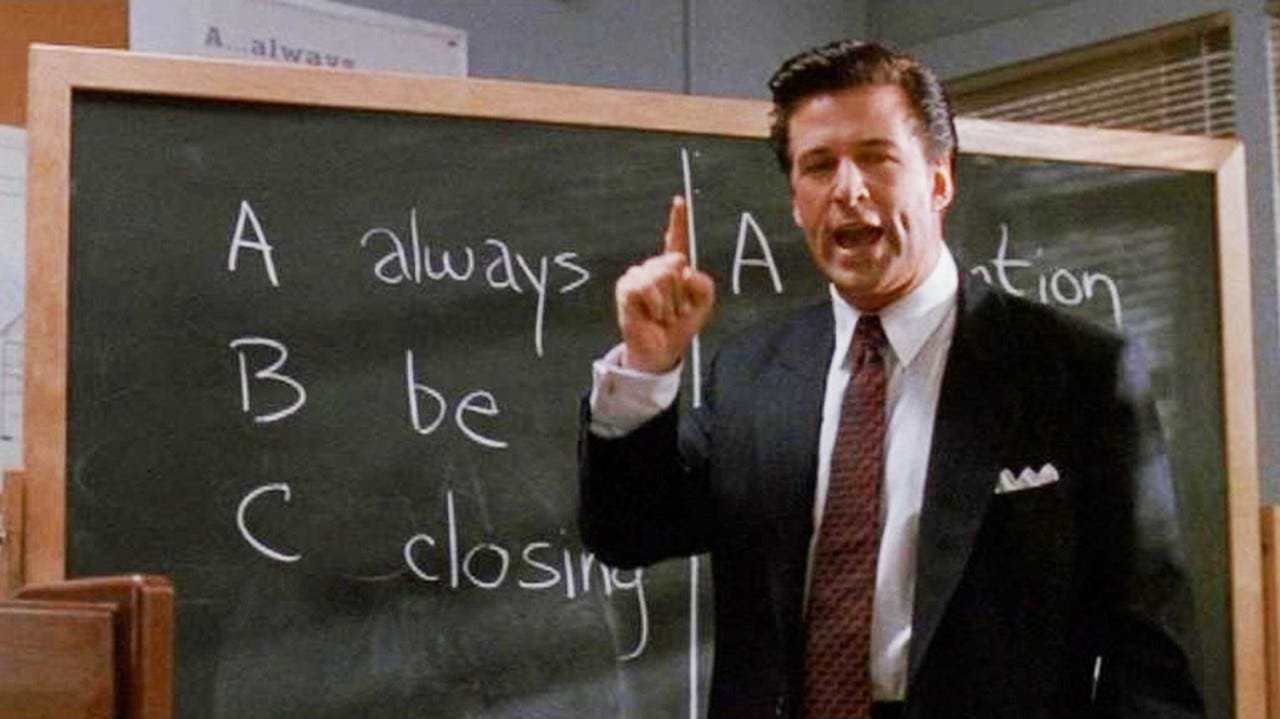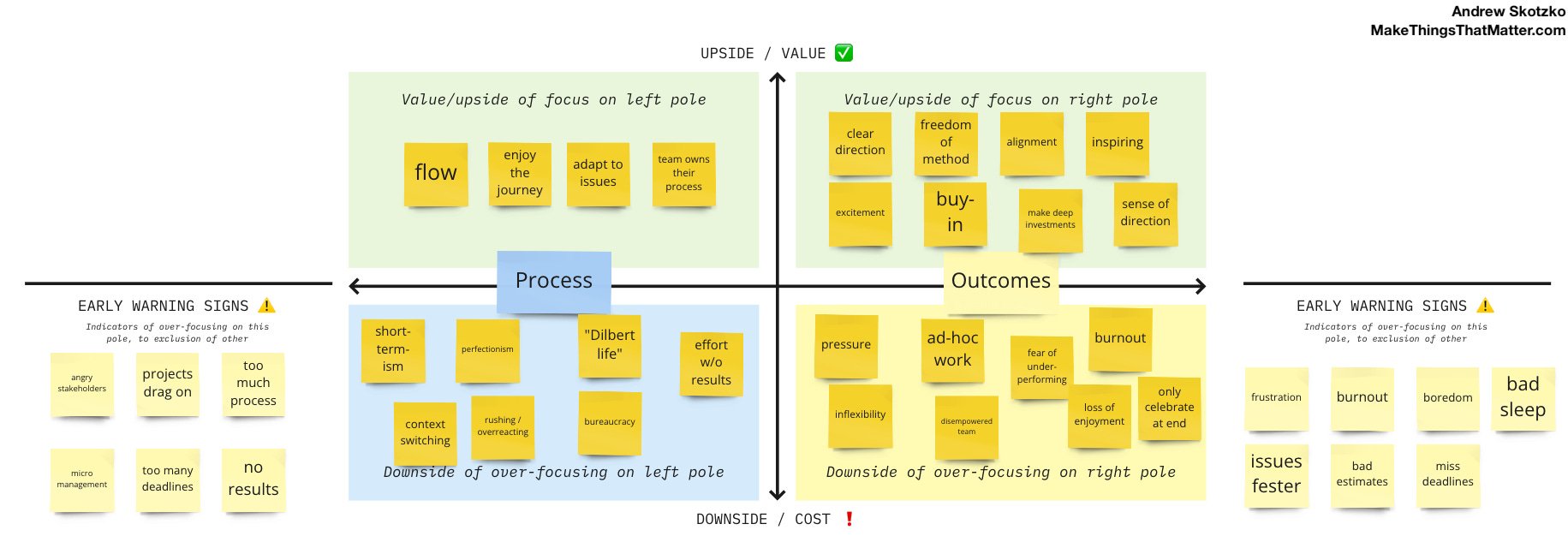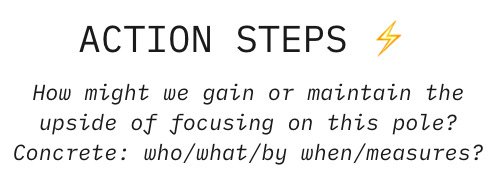Product Polarities
As product people, we live amidst uncertainty.
It's frustrating as hell when we can't solve a problem or resolve a situation. Our mind spins on it. We can't let go of it or put it down. It can drive us crazy, because we're problem solvers! (This goes double for engineers.)
Problem solving is so ingrained in us that we don't even realize that:
"problem solving" is our default lens on the world
this lens is not always the most useful approach to a situation, and
sometimes other lenses are more useful
Polarity management is a lens for handling unsolvable problems. This lens seems missing from the prescriptive, framework-heavy world of product. This article is my first attempt to introduce the concept.
Example: the one-off “sales special”
Imagine you're the VP Product in an enterprise software company. All of a sudden, you get an urgent text message from one of your PMs, telling you that they got a call from sales, asking the product team to implement a feature to close a marquee account. The salesperson says that BigCo is about to sign a 3-year, $2M deal—if we can just add one feature to make our product play nice with some of their legacy internal systems.
The PM told the sales rep that we can't commit to that right now. After all, we're not in the custom software business and we already committed to delivering other features this quarter that we believe will be valuable to many companies, not just BigCo. (Based on good evidence from discovery, mind you.)
The sales rep is incredulous—they've got $2M on the line, ready to close! They're escalating this to the VP Sales, who will be in the CEO's ear within the hour.
Crap. Now what?
If you give in and do the special, you may help short-term revenue but make the product worse and harder to maintain, as well as set a discouraging precedent. If you don't, product might be seen as not valuing the contribution or concerns of other functions and collaboration can grind to a halt. And won't this just keep happening, quarter after quarter?
Ah yes, the dreaded "sales special." This is a frustrating and common problem, the management of which is out of scope for this piece.
What I want you to realize is that this isn’t a "problem" at all.
It’s a polarity.
What’s a “polarity” and how is that different from a problem?
A polarity is an inherent, unsolvable tension in a system that is easily mistaken for a problem.
Problems can be solved. Polarities can only be managed.
Let's break that down. A polarity is a tension that is:
Inherent: the priorities of each side of the system conflict with one another
Unsolvable: this conflict will exist as long as these parts exist in a system together
Easily mistaken: by default, we treat everything as a problem that can be solved
Polarities arise from opposing forces at play that are built into a system. They cannot be permanently solved without removing one of the poles and fundamentally changing the system.
In our enterprise sales vs. product example above, tension will exist between product and sales as long as they both exist in system together. We could get permanently be rid of this tension by fundamentally changing the business to be (1) a custom services business (all sales, no product), or (2) pure self-serve SaaS (all product, no sales).
But as long as we want to be an enterprise software company, this tension will be here. Salespeople have a job: close deals. It's a hard job that is essential to the company, and they're justified in expecting collaboration from product. Product people also have a hard job: build a product that many customers love yet works across the many dimensions of the business.
Here are some common examples of polarities:
process vs outcomes: focusing on the work vs. the intended results
speed vs quality: get it done now vs. make it right
progress vs stability: destabilizing change vs. preserving what's working now
planning vs. action: deliberation and analysis vs. immediate action and momentum
I vs we: individuality vs. being part of something bigger (e.g. a romantic relationship, a work team, or a nation)
Words that hint at the presence of a polarity are "dilemma" or "paradox." You usually feel the frustration of a polarity before you grasp it intellectually.
A common sign of a polarity is when you "solve" an issue and it pops up again later in slightly different form.
Why are polarities hard?
Polarities are hard because of two root issues: expectations and certainty.
Expectations: We expect to solve a problem, and be done with it. Yet it keeps cropping up. Ugh! Thinking the "problem" can be resolved in a final way, we can drive ourselves crazy trying to do so. This expectation mismatch creates frustration.
Certainty: Humans love feeling certain. We resist paradox, uncertainty, tension. But navigating uncertain waters is required to innovate and make progress, which is the core of our work.
Polarities can be sources of tremendous progress, or great difficulty. It all depends on how they’re managed. If you manage a polarity well, you can get the best of both poles and minimize the downside of over-focusing on either.
In a well-managed polarity, you get more upside than downside (from UX Mastery)
Here is a short primer on how.
How to manage a polarity
Generally speaking, you manage a polarity by shifting your thinking from "or" to "and." As Barry Johnson writes in Polarity Management:
"The difficulty is the perception that [you] are dealing with a problem that can be solved by choosing either one or the other."
Step one: change your lens
The first and essential thing is to accept that you cannot solve a polarity.
This may not be what you want to hear.
A polarity is a tension between contradictory forces that are inherent to a system. It's not a matter of capability or intelligence. It's just unsolvable.
To make progress, you have to approach the situation from a different lens than problem solving or making an either/or choice.
Start by identifying:
what is the upside of balancing this polarity? why bother doing this at all?
what is likely to happen if we don’t balance this out?
To help make this concrete, I’ll share a real polarity map I did back in 2019 on the process/outcomes polarity while I was leading a large product group and feeling really stressed.
At this step, here’s what I had:
Upside vs downside
Step two: map the polarity
You need to externalize it to both get some distance from it, and to be able to better discuss it with others in step three. Draw a 2x2 grid.
For the left side of the polarity, identify the upsides/benefit/value of focusing on that pole. Then, identify the downsides/cost of over-focusing on the left pole to the exclusion of the right pole. Repeat for the right pole.
When you're done, it will look something like this:
Step three: identify early warning signs
Next, you want to brainstorm a few leading indicators that would tell you when you're over-focusing on one pole at the expense of the other. These are our canaries in the coal mine that will tell us we are getting into the downside, by over focusing on one pole.
Your map should now look something like this:
Step four: brainstorm action steps
Now brainstorm actions you can take to gain or maintain the upside of focusing on the left pole.
Make them concrete: who, what, by when? What are the measures?
Repeat for the right pole.
Your map should now be complete, and look like this:
Step five: have a discussion about how to manage it
Take your map, and have a candid conversation with the person who represents the other pole in this situation. This may be a colleague, a romantic partner, or someone in your community you feel tension with. If this is an internal dilemma rather than an interpersonal conflict, share it with a friend, therapist, coach, or thought partner.
Take ownership for your role in contributing to the situation, and talk about what you see in a non-blaming, non-attacking way. Come at this from a collaborative stance of trying to make progress and valuing all parties.
Action steps
Three action items:
Next time you're frustrated with a problem, ask yourself: is this a problem to solve, a polarity to manage?
Do a mental sweep of the issues in your work right now. Can you identify one polarity in there? (Hint: check if they are all new issues, or if any is a new variant of a recurring challenge.)
Using the approach above and this polarity mapping template, map out one polarity and start addressing it.
If you have any questions about this article, or are interested in exploring how to apply these ideas in your context via product coaching, please reach out here.









